3.3E: Exercises
( \newcommand{\kernel}{\mathrm{null}\,}\)
Section Exercises
Verbal
1. Explain the difference between the coefficient of a power function and its degree.
Answer: The coefficient of the power function is the real number that is multiplied by the variable raised to a power. The degree is the highest power appearing in the function.
2. If a polynomial function is in factored form, what would be a good first step in order to determine the degree of the function?
3. In general, explain the end behavior of a power function with odd degree if the leading coefficient is positive.
Answer: As x decreases without bound, so does f(x). As x increases without bound, so does f(x).
4. What is the relationship between the degree of a polynomial function and the maximum number of turning points in its graph?
5. What can we conclude if, in general, the graph of a polynomial function exhibits the following end behavior? As x→−∞, f(x)→−∞ and as x→∞, f(x)→−∞.
Answer: The polynomial function is of even degree and leading coefficient is negative.
Algebraic
For the following exercises, identify the function as a power function, a polynomial function, or neither.
6. f(x)=x5
7. f(x)=(x2)3
Answer: Power function
8. f(x)=x−x4
Exercise 3.3E.9
f(x)=x2x2−1
- Answer
-
Neither
10. f(x)=2x(x+2)(x−1)2
11. f(x)=3x+1
Answer: Neither
For the following exercises, find the degree and leading coefficient for the given polynomial.
12. −3x4
13. 7−2x2
Answer: Degree = 2, Coefficient = –2
14. −2x2−3x5+x−6
15. x(4−x2)(2x+1)
Answer: Degree =4, Coefficient = –2
16. x2(2x−3)2
For the following exercises, determine the end behavior of the functions.
17. f(x)=x4
Answer: As x→∞, f(x)→∞, as x→−∞, f(x)→∞
18. f(x)=x3
19. f(x)=−x4
Answer: As x→−∞, f(x)→−∞, as x→∞, f(x)→−∞
20. f(x)=−x9
21. f(x)=−2x4−3x2+x−1
Answer: As x→−∞, f(x)→−∞, as x→∞, f(x)→−∞
22. f(x)=3x2+x−2
23. f(x)=x2(2x3−x+1)
Answer: As x→∞, f(x)→∞, as x→−∞, f(x)→−∞
24. f(x)=(2−x)7
For the following exercises, find the intercepts of the functions.
25. f(t)=2(t−1)(t+2)(t−3)
Answer: y-intercept is (0,12), t-intercepts are (1,0);(–2,0); and (3,0).
26. g(n)=−2(3n−1)(2n+1)
Exercise 3.3E.27
f(x)=x4−16
- Answer
-
y-intercept is (0,−16). x-intercepts are (2,0) and (−2,0).
28. f(x)=x3+27
29. f(x)=x(x2−2x−8)
Answer: y-intercept is (0,0). x-intercepts are (0,0),(4,0), and (−2,0).
30. f(x)=(x+3)(4x2−1)
Graphical
For the following exercises, determine the least possible degree of the polynomial function shown.
31.
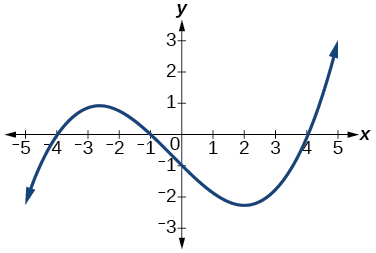
Answer: 3
32.
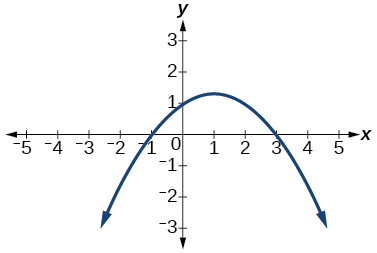
33.

Answer: 5
34.
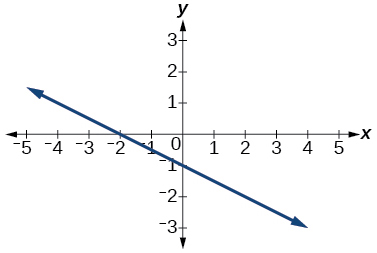
35.
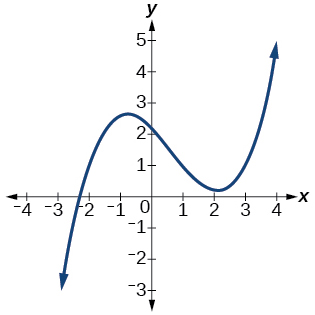
Answer: 3
36.
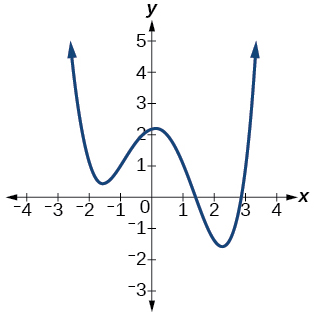
37.
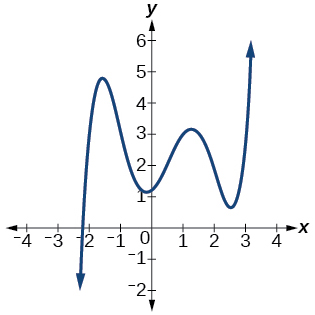
Answer: 5
38.
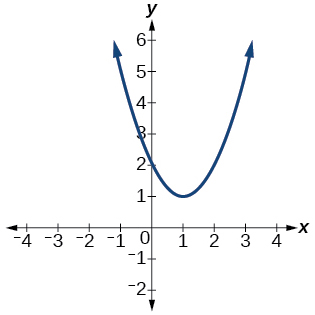
For the following exercises, determine whether the graph of the function provided is a graph of a polynomial function. If so, determine the number of turning points and the least possible degree for the function.
39.
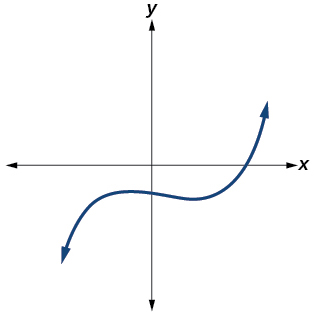
Answer: Yes. Number of turning points is 2. Least possible degree is 3.
40.
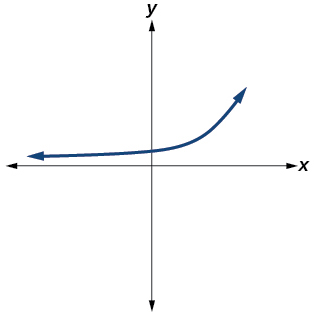
41.
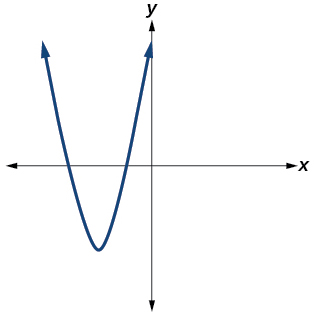
Answer: Yes. Number of turning points is 1. Least possible degree is 2.
42.
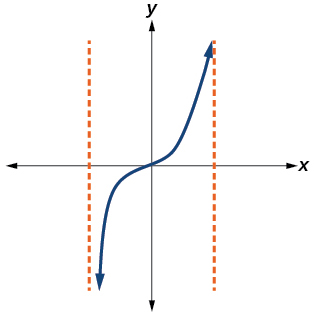
43.
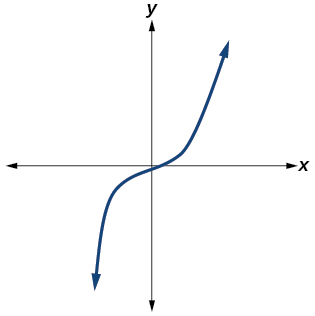
Answer: Yes. Number of turning points is 0. Least possible degree is 3.
Exercise 3.3E.44
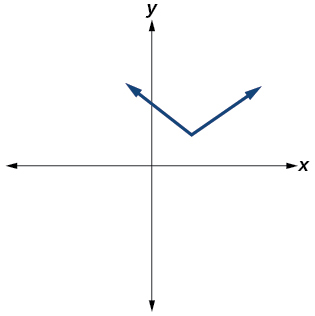
- Answer
-
No (the graph is not smooth)
45.
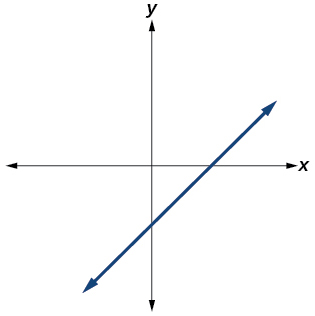
Answer: Yes. Number of turning points is 0. Least possible degree is 1.
Numeric
For the following exercises, make a table to confirm the end behavior of the function.
46. f(x)=−x3
47. f(x)=x4−5x2
Answer:
| x | f(x) |
|---|---|
| 10 | 9,500 |
| 100 | 99,950,000 |
| –10 | 9,500 |
| –100 | 99,950,000 |
as x→−∞, f(x)→∞, as x→∞, f(x)→∞
48. f(x)=x2(1−x)2
49. f(x)=(x−1)(x−2)(3−x)
Answer:
| x | f(x) |
|---|---|
| 10 | 9,500 |
| 100 | 99,950,000 |
| –10 | 9,500 |
| –100 | 99,950,000 |
as x→−∞, f(x)→∞, as x→∞, f(x)→−∞
50. f(x)=x510−x4
Technology
For the following exercises, graph the polynomial functions using a calculator. Based on the graph, determine the intercepts and the end behavior.
51. f(x)=x3(x−2)
Answer:
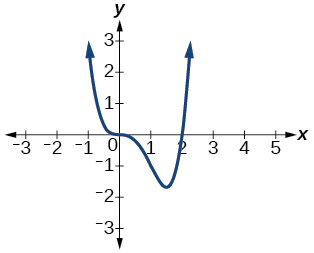
The y-intercept is (0,0). The x-intercepts are (0,0),(2,0). As x→−∞, f(x)→∞, as x→∞, f(x)→∞
52. f(x)=x(x−3)(x+3)
53. f(x)=x(14−2x)(10−2x)
Answer:
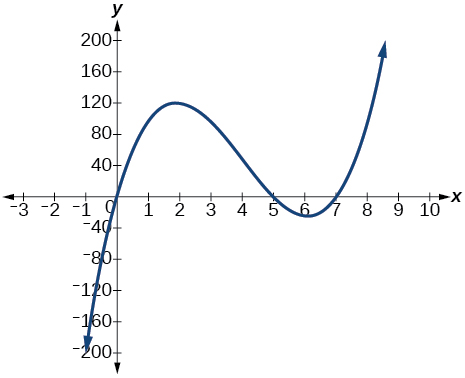
The y-intercept is (0,0) . The x-intercepts are (0,0),(5,0),(7,0). As x→−∞, f(x)→−∞, as x→∞, f(x)→∞
54. f(x)=x(14−2x)(10−2x)2
55. f(x)=x3−16x
Answer:
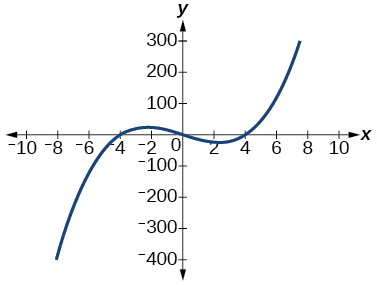
The y-intercept is (0, 0). The x-intercept is (−4,0),(0,0),(4,0). As x→−∞, f(x)→−∞, as x→∞, f(x)→∞
56. f(x)=x3−27
57. f(x)=x4−81
Answer:
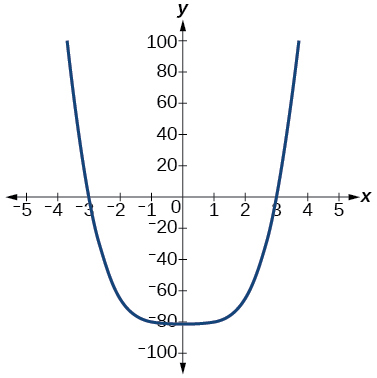
The y-intercept is (0, −81). The x-intercept are (3,0),(−3,0). As x→−∞, f(x)→∞, as x→∞, f(x)→∞
58. f(x)=−x3+x2+2x
59. f(x)=x3−2x2−15x
Answer:
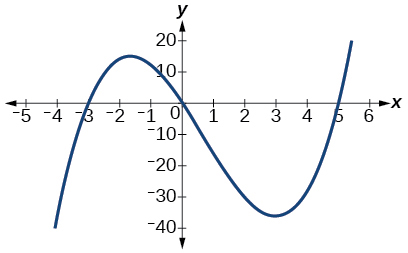
The y-intercept is (0,0). The x-intercepts are (−3,0),(0,0),(5,0). As x→−∞, f(x)→−∞, as x→∞, f(x)→∞
60. f(x)=x3−0.01x
Extensions
For the following exercises, use the information about the graph of a polynomial function to determine the function. Assume the leading coefficient is 1 or –1. There may be more than one correct answer.
61. The y-intercept is (0,−4). The x-intercepts are (−2,0),(2,0). Degree is 2.
End behavior: as x→−∞, f(x)→∞, as x→∞, f(x)→∞.
Answer: f(x)=x2−4
62. The y-intercept is (0,9). The x-intercepts are (−3,0),(3,0). Degree is 2.
End behavior: as x→−∞, f(x)→−∞, as x→∞, f(x)→−∞.
63. The y-intercept is (0,0). The x-intercepts are (0,0),(2,0). Degree is 3.
End behavior: as x→−∞, f(x)→−∞, as x→∞, f(x)→∞.
Answer: f(x)=x3−4x2+4x
64. The y-intercept is (0,1). The x-intercept is (1,0). Degree is 3.
End behavior: as x→−∞, f(x)→∞, as x→∞, f(x)→−∞.
65. The y-intercept is (0,1). There is no x-intercept. Degree is 4.
End behavior: as x→−∞, f(x)→∞, as x→∞, f(x)→∞.
Answer: f(x)=x4+1
Real-World Applications
For the following exercises, use the written statements to construct a polynomial function that represents the required information.
66. An oil slick is expanding as a circle. The radius of the circle is increasing at the rate of 20 meters per day. Express the area of the circle as a function of d, the number of days elapsed.
67. A cube has an edge of 3 feet. The edge is increasing at the rate of 2 feet per minute. Express the volume of the cube as a function of m, the number of minutes elapsed.
Answer: V(m)=8m3+36m2+54m+27
68. A rectangle has a length of 10 inches and a width of 6 inches. If the length is increased by x inches and the width increased by twice that amount, express the area of the rectangle as a function of x.
Exercise 3.3E.69
An open box is to be constructed by cutting out square corners of x-inch sides from a piece of cardboard 8 inches by 8 inches and then folding up the sides. Express the volume of the box as a function of x.
- Answer
-
V(x)=4x3−32x2+64x
70. A rectangle is twice as long as it is wide. Squares of side 2 feet are cut out from each corner. Then the sides are folded up to make an open box. Express the volume of the box as a function of the width (x).

